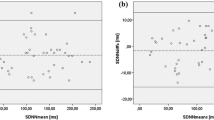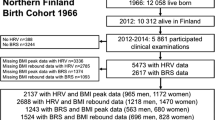Abstract
Heart rate variability (HRV) is a non-invasive quantitative marker of cardiac autonomic function derived from continuous electrocardiogram (ECG) recordings. Normative HRV values and development factors have not been established in pediatric populations. The objective was to derive referent time- and frequency-domain HRV values for a population-based sample of children. Children aged 9–11 years (N = 1,036) participated in the Québec Longitudinal Study of Child Development cohort cardiovascular health screening. Registered nurses measured anthropometrics (height, weight) and children wore an ambulatory Holter monitor to continuously record an ECG signal. HRV variables included time (SDNN, pNN50, RMSSD, SDANN) and frequency (HF, LF, LF/HF ratio) domain variables. Normative HRV values, stratified by age, sex, and heart rate, are presented. Greater heart rate (β avg = −0.60, R 2avg = 0.39), pubertal maturation (β avg = −0.11, R 2avg = 0.01), later ECG recording times (β avg = −0.19, R 2avg = 0.07), and higher diastolic blood pressure (β avg = −0.11, R 2avg = 0.01) were significantly associated with reduced HRV in 10-year-old children. The normative HRV values permit clinicians to monitor, describe, and establish pediatric nosologies in primary care and research settings, which may improve treatment of diseases associated with HRV in children. By better understanding existing values, the practical applicability of HRV among clinicians will be enhanced. Lastly, developmental (e.g., puberty) and procedural (e.g., recording time) factors were identified that will improve recording procedures and interpretation of results.
Similar content being viewed by others
Abbreviations
- HRV:
-
Heart rate variability
- SBP:
-
Systolic blood pressure
- DBP:
-
Diastolic blood pressure
- SDNN:
-
Standard deviation of all normal sinus RR intervals
- SDANN:
-
Standard deviation of the averaged normal sinus RR intervals for all 5-min epochs
- SDNNi:
-
Mean of the standard deviations of all normal sinus RR intervals for all 5-min epochs
- rMSSD:
-
Root mean square of the successive normal sinus RR interval difference
- pNN50:
-
Percentage of successive normal sinus RR intervals <50 ms
- VLF:
-
Very low frequency
- LF:
-
Low frequency
- HF:
-
High frequency
References
Berntson GG, Cacioppo JT, Quigley KS (1993) Cardiac psychophysiology and autonomic space in humans: empirical perspectives and conceptual implications. Psychol Bull 114:293–322
Berntson GG, Bigger JT, Eckberg DL, Grossman P, Kaufmann PG, Malik M et al (1997) Heart rate variability: origins, methods, and interpretive caveats. Psychophysiology 34(6):623–648
Białłkowski J, Karwot B, Szkutnik M, Sredniawa B et al (2003) Comparison of heart rate variability between surgical and interventional closure of atrial septal defect in children. Am J Cardiol 92:356–358
Blom EH, Olsson EMG, Serlachius E, Ericson M, Ingvar M (2009) Heart rate variability is related to self-reported physical activity in a healthy adolescent population. Europ J Appl Physiol 106(6):877–883
Chen S-R, Chiu H-W, Lee Y-J, Sheen T-C, Jeng C (2012) Impact of pubertal development and physical activity on heart rate variability in overweight and obese children in Taiwan. J Sch Nurs 4:284–290
Faulkner MS, Hathaway D, Tolley B (2003) Cardiovascular autonomic function in healthy adolescents. Heart Lung 32:10–22
Finley J, Nugent ST (1995) Heart rate variability in infants, children and young adults. J Auto Nerv 51:103–108
Finley JP, Nugent ST, Hellenbrand W (1987) Heart-rate variability in children. Spectral analysis of developmental changes between 5 and 24 years. Can J Physiol Pharmacol 65(10):2048–2052
Fleming S, Thompson M, Stevens R, Heneghan C, Plüddemann A, Maconochie I et al (2011) Normal ranges of heart rate and respiratory rate in children from birth to 18 years of age: a systematic review of observational studies. Lancet 377:1011–1018
Fujiwara J, Kimura S, Tsukayama H, Nakahara S, Haibara S et al (2004) Evaluation of the autonomic nervous system function in children with primary monosymptomatic nocturnal enuresis-power spectrum. Scand J Urol Nephrol 35:350–356
Golding J, Pembrey M, Jones R, The Alspac Study Team (2001) ALSPAC–the avon longitudinal study of parents and children. Paed Perin Epidemiol 15:74–87
Guo YF, Stein PK (2003) Circadian rhythm in the cardiovascular system. Am Heart J 145:779–786
Hon EH, Lee ST (1965) Electronic evaluations of the fetal heart rate patterns preceding fetal death, further observations. Am J Obstet Gynae 87:814–826
Jetté M (2002) Survey description and methodology: Part I. Logistics and longitudinal data collections. Quebec Longitudinal Study of Child Development (QLSCD 1998–2000, Vol. 2, No. 1). Institut de la Statistique du Quebec, Quebec
Katheria A, Rich W, Finer N (2012) Electrocardiogram provides a continuous heart rate faster than oximetry during neonatal resuscitation. Pediatrics 130:1177–1181
Kaufman CL, Kaiser DR, Steinberger J, Dengel DR (2007) Relationships between heart rate variability, vascular function, and adiposity in children. Clin Auton Res 17(3):165–171
Kleiger RE, Miller JP, Bigger JT, Moss AR (1987) Multicenter post-infarction research group: decreased heart rate variability and its association with increased mortality after acute myocardial infarction. Am J Cardiol 59:256–262
Kwok K-L, Yung T-C, Ng DK, Chan C-H, Lau W-F, Fu Y-M (2011) Heart rate variability in childhood obstructive sleep apnea. Ped Pulmonol 210:205–210
Lenard Z, Studinger P, Mersich B, Kocsis L, Kollai M (2004) Maturation of cardiovagal autonomic function from childhood to young adult age. Circulation 110(16):2307–2312
Liao D, Li X, Rodriguez-Colon SM, Liu J, Vgontzas AN, Calhoun S, Bixler EO (2010) Sleep-disordered breathing and cardiac autonomic modulation in children. Sleep Med 11(5):484–848
Malpas S, Purdie GL (1990) Circadian variation of heart rate variability. Cardiovasc Res 24:210–213
Martini G, Riva P, Rabbia F, Molini V, Ferrero GB, Cerutti F, Carra R et al (2001) Heart rate variability in childhood obesity. Clin Auton Res 11(2):87–91
Massin M, von Bernuth G (1997) Normal ranges of heart rate variability during infancy and childhood. Ped Cardiol 18:297–302
Massin MM, Maeyns K, Withofs N, Ravet F, Gérard P (2000) Circadian rhythm of heart rate and heart rate variability. Arch Dis Child 83:179–182
Morris NM, Udry JR (1980) Validation of a self-administered instrument to assess stage of adolescent development. J Youth Adolesc 9:271–280
Nagai N, Matsumoto T, Kita H, Moritani T (2003) Autonomic nervous system activity and the state and development of obesity in Japanese school children. Obes Res 11(1):25–32
Netherton C, Goodyer I, Tamplin A, Herbert J (2004) Salivary cortisol and dehydroepiandrosterone in relation to puberty and gender. Psychoneuroendocrinology 29:125–140
Ogden CL, Kuczmarski RJ, Flegal KM, Mei Z, Guo S, Wei R et al (2002) Growth charts for the United States: improvements to the 1977 National Center for Health Statistics Version. Pediatrics 109:45–60
Ordaz S, Luna B (2012) Sex differences in physiological reactivity to acute psychosocial stress in adolescence. Psychoneuroendocrinology. doi:10.1016/j.psyneuen.2012.01.002
Palatini P, Julius S (2009) The role of cardiac autonomic function in hypertension and cardiovascular disease. Curr Hypertens Rep 11:199–205
Reed KE, Warburton DER, Whitney CL, McKay HA (2006) Differences in heart rate variability between Asian and Caucasian children living in the same Canadian community. Appl Physiol Nutr Metab 31:277–282
Rodríguez-colón SM, He F, Shaffer ML, Li X, Vgontzas AN, Bixler EO et al (2011) Insomnia symptoms and sleep duration are associated with impaired cardiac autonomic modulation in children. Neurosci Med. 2:288–294
Rodríguez-Colón SM, Bixler EO, Li X, Vgontzas AN, Liao D (2011) Obesity is associated with impaired cardiac autonomic modulation in children. IJPO 6(2):128–134
Rogol AD, Clark PA, Roemmich JN (2000) Growth and pubertal development in children and adolescents: effects of diet and physical activity. Am J Clin Nutr 72:521s–528s
Rydberg A, Rask P, Hörnsten R, Teien D (2004) Heart rate variability in children with Fontan circulation. Ped Cardiol 25(4):365–369
Schroeder EB, Duanping L, Chambless LE, Prineas RJ, Evans GW, Heiss G (2003) Hypertension, blood pressure, and heart rate variability. The atherosclerosis risk in communities (ARIC) study. Hypertension 42:1106–1111
Silvetti MS, Drago F, Ragonese P (2001) Heart rate variability in healthy children and adolescents is partially related to age and gender. Int J Cardiol 81:169–174
Stein PK, Kleiger RE, Rottman JN (1997) Differing effects of age on heart rate variability in men and women. Am J Cardiol 80:302–305
Task Force of the European Society of Cardiology (1996) Heart rate variability: standards of measurement, physiological interpretation and clinical use. Circulation 93:1043–1065
Thayer JF, Sternberg E (2006) Beyond heart rate variability: vagal regulation of allostatic systems. Ann N Y Acad Sci 1088:361–372
Tremaine RB, Dorrian J, Blunden S (2010) Measuring sleep habits using the sleep timing questionnaire: a validation study for school-age children. Sleep Biol Rhythms 8:194–202
Tsuji H, Venditti FJ, Manders ES, Evans JC, Larson MG, Feldman CL et al (1996) Determinants of heart rate variability. J Am Coll Cardiol 28:1539–1546
Umetani K, Singer DH, McCraty R, Atkinson M (1998) Twenty-four hour time domain heart rate variability and heart rate: relations to age and gender over nine decades. J Am Col Card 31(3):593–601
Wallis LA, Healy M, Undy MB, Maconochie I (2005) Age related reference ranges for respiration rate and heart rate from 4 to 16 years. Arch Dis Child 90:1117–1121
Wang X, Thayer JF, Treiber F, Snieder H (2005) Ethnic differences and heritability of heart rate variability in African- and European American youth. Am J Cardiol 96:1166–1172
Wawryk AM, Bates DJ, Couper JJ (1997) Power spectral analysis of heart rate variability in children and adolescents with IDDM. Diabetes Care 20:1416–1421
Webber LS, Osganian V, Luepker RV, Feldman HA, Stone EJ et al (1995) Cardiovascular risk factors among 3rd grade children in four regions of United States: the CATCH study. Am J Epidemiol 141:428–439
Winsley RJ, Armstrong N, Bywater K, Fawkner SG (2003) Reliability of heart rate variability measures at rest and during light exercise in children. Brit J Sports Med 37(6):550–552
Wolfson AR, Carskadon MA (1998) Sleep schedules and daytime functioning in adolescents. Child Dev 69:875–887
Yamasaki Y, Kodama M, Matsuhisa M (1996) Diurnal heart rate variability in healthy subjects: effects of aging and sex differences. Am J Physiol 271:303–310
Acknowledgments
The authors extend their sincere thanks to Drs. Marie Lambert (posthumous) and Blaine Ditto for their invaluable contributions at the inception of this project. The principal financial contributors of the 1996-2014 ELDEQ cohort were Institut de la statistique du Québec and their partners: Fondation Lucie et André Chagnon, Ministère de la Santé et des Services sociaux du Québec, Ministère de la Famille du Québec, Research Unit on Childhood Psychosocial Maladjustment, Centre hospitalier universitaire Sainte-Justine, and Institut de recherche Robert-Sauvé en santé et en sécurité du travail. The cardiovascular screening assessment of the ELDEQ cohort was funded by the Canadian Institutes of Health Research (# 00309MOP-123079, #HDF-70335). Institut de recherché en santé publique de l’Université de Montréal, Centre hospitalier universitaire Sainte-Justine, and Centre de recherche du Centre hospitalier de l’Université de Montréal received infrastructure funding from Fonds de la recherche en santé du Québec. This research was in part conducted by members of TEAM PRODIGY, an inter-university research team including Université de Montréal, Concordia University, Université Laval, McGill University, and University of Toronto.
Conflict of interest
Dr. Jennifer McGrath reports grants (#OCO-79897, #MOP-89886) and a New Investigator Award (#MSH95353) from Canadian Institutes of Health Research that supported this research. Dr. Jacques Montplaisir reports personal fees from Sanofi-Aventis, Servier, Merck, Jazz Pharm, Valeant Pharm, Impax Laboratories, Otsuka Pharm, and grants from Merck and GSK, outside the submitted work. Dr. Jean R. Séguin reports grants from Canadian Institutes of Health Research (Grants #MOP-44072) and Fonds de recherche en santé du Québec (#991027, #981055). All remaining authors have nothing to disclose.
Author information
Authors and Affiliations
Corresponding author
Rights and permissions
About this article
Cite this article
Jarrin, D.C., McGrath, J.J., Poirier, P. et al. Short-Term Heart Rate Variability in a Population-Based Sample of 10-Year-Old Children. Pediatr Cardiol 36, 41–48 (2015). https://doi.org/10.1007/s00246-014-0962-y
Received:
Accepted:
Published:
Issue Date:
DOI: https://doi.org/10.1007/s00246-014-0962-y




